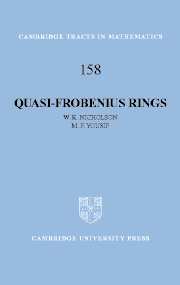Book contents
- Frontmatter
- Contents
- List of Symbols
- Preface
- 1 Background
- 2 Mininjective Rings
- 3 Semiperfect Mininjective Rings
- 4 Min-CS Rings
- 5 Principally Injective and FP Rings
- 6 Simple Injective and Dual Rings
- 7 FGF Rings
- 8 Johns Rings
- 9 A Generic Example
- A Morita Equivalence
- B Perfect, Semiperfect, and Semiregular Rings
- C The Camps–Dicks Theorem
- Questions
- Bibliography
- Index
3 - Semiperfect Mininjective Rings
Published online by Cambridge University Press: 14 September 2009
- Frontmatter
- Contents
- List of Symbols
- Preface
- 1 Background
- 2 Mininjective Rings
- 3 Semiperfect Mininjective Rings
- 4 Min-CS Rings
- 5 Principally Injective and FP Rings
- 6 Simple Injective and Dual Rings
- 7 FGF Rings
- 8 Johns Rings
- 9 A Generic Example
- A Morita Equivalence
- B Perfect, Semiperfect, and Semiregular Rings
- C The Camps–Dicks Theorem
- Questions
- Bibliography
- Index
Summary
Only in the semiperfect case does the full power of the mininjective hypothesis comes into focus. The reason is that we can get combinatorial information about the simple right and left ideals because a semiperfect ring has only a finite number of simple right modules that are represented in the ring by basic idempotents. We remind the reader that all the facts needed about semiperfect rings are developed in Appendix B.
We begin by characterizing the semiperfect, right mininjective rings, and we use the result to give easy proofs of two well-known characterizations of quasi-Frobenius rings: R is quasi-Frobenius if and only if it is left and right artinian, both soc(Re) and soc(eR) are simple for every local idempotent e in R, and either Sr = Sι or R is right and left Kasch. The following class of rings is important in extending these results. A Ring R is called a right minfull ring if it is semiperfect, right mininjective, and soc(eR) ≠ 0 for every local idempotent e ∈ R. We show that these right minfull rings are a Morita invariant class that exhibits many of the basic properties of quasi-Frobenius rings. In particular, they are right and left Kasch, and Sr = Sι if and only if lr(K) = K for every minimal left ideal K that is contained in Re for some local idempotent e.
- Type
- Chapter
- Information
- Quasi-Frobenius Rings , pp. 56 - 77Publisher: Cambridge University PressPrint publication year: 2003



